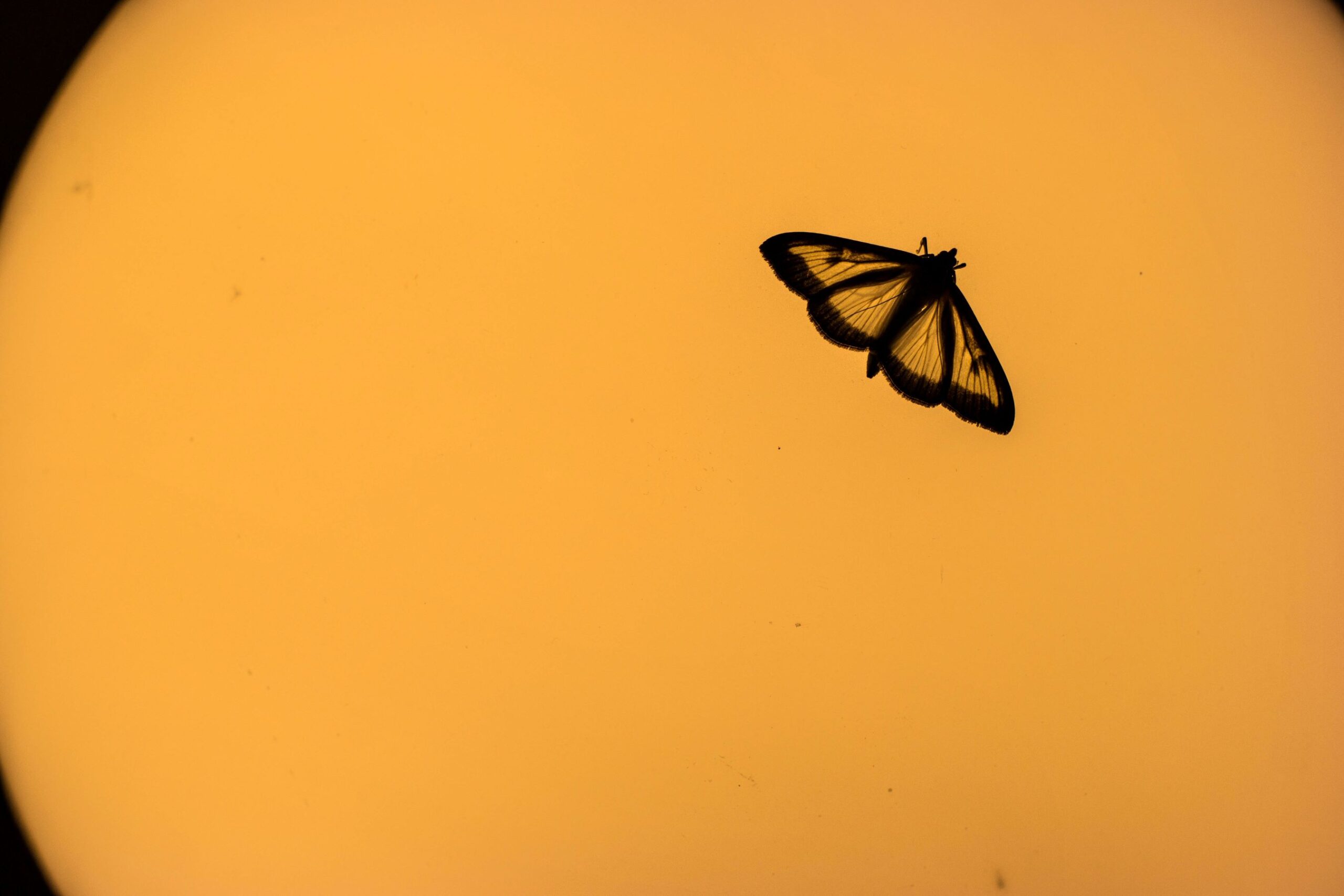
(Shutterstock)
Humans are the ones who fly straight into the flame. Lost causes, unrequited loves, crazy gambles, consuming addictions, dangerous exploits—we live bent, one would guess, on self-destruction.
All the poor moths want to do is set a flight path.
When their light sources were the moon and stars, all went well. But our candles and bonfires, streetlamps and light fixtures dazzle and dizzy them. Flying through blackness is disorienting, so moths tilt their backs to the night sky’s radiance in order to find the ground, see which way gravity sucks, and fly level. Now, thanks to us, the brightest lights are bulbs instead of stars, and they burn too close and too low. Moths have to twist their delicate bodies to keep the correct tilt, and they wind up flying in a loop, around and around the light source. In horror, not fascination.
For centuries, we thought these unwilling suicide missions were deliberate. We were grateful: they gave us a near-universal metaphor for our own folly. Writers described characters como polilla a la luz or wie das Licht die Motten anzieht (like a moth to the light), attiré comme un papillon de nuit par la flamme (drawn like a night butterfly to the flame).
In Merchant of Venice, Portia sighs, “Thus hath the candle singed the moth/ O, these deliberate fools, when they do choose,/ They have the wisdom by their wit to lose.”
In A Streetcar Named Desire, Blanche is introduced as a fragile white moth—one that will be drawn inexorably, perilously, to the glare and heat of Stanley Kowalski. To escape him, what does she finally scream? “Fire!”
In a poem about suicide, Anne Sexton coldly warns us about “the moths/forced by circumstance/to suck on the electric bulb.”
But who are we fooling? Western culture adores self-destruction, even envies it. In Archie and Mehitabel, Don Marquis wrote: “and before i could argue him/ out of his philosophy/ he went and immolated himself/on a patent cigar lighter.” The poem tsks regret, then admits, “at the same time i wish/ there was something i wanted/ as badly as he wanted to fry himself.”
We shiver at the image but learn nothing. Romantics, as Shelley wrote, “Like moths by light attracted & repelled,/ Oft to new bright destruction come & go.”
The moths, though. They are not, science now knows, drawn inexorably by the beauty of that golden light. Nor are they so filled with passionate desire that they crave their own immolation. Nor do they court danger on purpose, finding it more alluring than safety.
They just want to fly.
Once we blamed “positive phototaxis” for their deaths, concluding that, like good Christians and supernaturalists, they moved toward the light to escape the darkness. What silliness. Moths who fly at night are at home in the dark. They need no more than a Boy Scout’s flashlight to find their way. They are not, as we also hypothesized, mistaking our lights for the moon and trying to land there.
Today’s super-fast, high-res infrared photography reveals the tragic truth: the moths are not moving toward the flame at all. They wriggle away from its shine like somebody blinded by an interrogator’s harsh spotlight. Rather than being lured to the light, they get trapped as they try to fly past it, according to findings just published in Nature Communications. Once caught, they are held in a crazy orbit, their bodies turned away from the light but unable to break free. They can no longer get their bearings as they once did. Seeing their disorientation, bats swoop down and devour them, further reducing the planet’s crucial insect count.
What do we do? Shroud artificial light and aim it at the ground. Choose lights with longer, less attractive wavelengths. Stop making assumptions—about bugs, and about ourselves. Humans who seem eager to die—or who burn up young in a hot flare of genius—are sometimes trapped, too. Ask any therapist how many clients have been foiled by old coping mechanisms that stopped working when the situation changed.
The moth-to-flame metaphor lasted for good reason. It colors our attitudes toward saintly masochism, heroic idiocy, great and stupid loves, magnificent obsessions that sop up people’s money and leave their families starved for affection and bread. And it leaves us as confused as the insects. “I surpassed myself, the suffering one; I carried my own ashes to the mountain; a brighter flame I contrived for myself,” writes Nietzsche (of course, Nietzsche), only to warn us a few sentences later not to be consumed by a burning passion.
We have been dancing around flame for a long time, caught up in old quests for romance or grandeur, risking our lives with a trick that stopped working when the world changed.
Read more by Jeannette Cooperman here.
